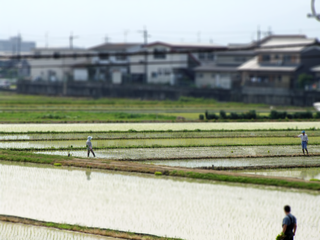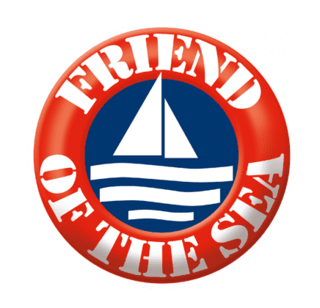Related Research Articles

Generally, a fishery is an entity engaged in raising or harvesting fish which is determined by some authority to be a fishery. According to the FAO, "...a fishery is an activity leading to harvesting of fish. It may involve capture of wild fish or raising of fish through aquaculture." It is typically defined in terms of the "people involved, species or type of fish, area of water or seabed, method of fishing, class of boats, purpose of the activities or a combination of the foregoing features". The definition often includes a combination of fish and fishers in a region, the latter fishing for similar species with similar gear types.

Overfishing is the removal of a species of fish from a body of water at a rate that the species cannot replenish in time, resulting in those species either becoming depleted or very underpopulated in that given area. According to a highly contested 2006 article in the journal Science, if fishing rates continue unchanged, all the world's fisheries will have collapsed by the year 2048. In a Food and Agriculture Organization of the United Nations 2018 report, the FAO estimates that one-third of world fish stocks were overfished by 2015.

A conventional idea of a sustainable fishery is that it is one that is harvested at a sustainable rate, where the fish population does not decline over time because of fishing practices. Sustainability in fisheries combines theoretical disciplines, such as the population dynamics of fisheries, with practical strategies, such as avoiding overfishing through techniques such as individual fishing quotas, curtailing destructive and illegal fishing practices by lobbying for appropriate law and policy, setting up protected areas, restoring collapsed fisheries, incorporating all externalities involved in harvesting marine ecosystems into fishery economics, educating stakeholders and the wider public, and developing independent certification programs.
Fisheries management is the activity of protecting fishery resources so sustainable exploitation is possible, drawing on fisheries science, and including the precautionary principle. Modern fisheries management is often referred to as a governmental system of appropriate management rules based on defined objectives and a mix of management means to implement the rules, which are put in place by a system of monitoring control and surveillance. A popular approach is the ecosystem approach to fisheries management. According to the Food and Agriculture Organization of the United Nations (FAO), there are "no clear and generally accepted definitions of fisheries management". However, the working definition used by the FAO and much cited elsewhere is:
The integrated process of information gathering, analysis, planning, consultation, decision-making, allocation of resources and formulation and implementation, with enforcement as necessary, of regulations or rules which govern fisheries activities in order to ensure the continued productivity of the resources and the accomplishment of other fisheries objectives.

The Common Fisheries Policy (CFP) is the fisheries policy of the European Union (EU). It sets quotas for which member states are allowed to catch each type of fish, as well as encouraging the fishing industry by various market interventions. In 2004 it had a budget of €931 million, approximately 0.75% of the EU budget.

Oncorhynchus is a genus of fish in the family Salmonidae; it contains the Pacific salmon and Pacific trout. The name of the genus is derived from the Greek onkos ("hook") and rynchos ("nose"), in reference to the hooked jaws of males in the mating season.
The Committee on Fisheries (PECH) is a committee of the European Parliament.

Agriculture, farming, and fishing form the primary sector of industry of the Japanese economy together with the Japanese mining industry, but together they account for only 1.3% of gross national product. Only 20% of Japan's land is suitable for cultivation, and the agricultural economy is highly subsidized.

Artisanal fishing are various small-scale, low-technology, low-capital, fishing practices undertaken by individual fishing households. Many of these households are of coastal or island ethnic groups. These households make short fishing trips close to the shore. Their produce is usually not processed and is mainly for local consumption. Artisan fishing uses traditional fishing techniques such as rod and tackle, fishing arrows and harpoons, cast nets, and small traditional fishing boats.

Illegal, unreported and unregulated fishing (IUU) is an international issue around the world. Fishing industry observers believe IUU occurs in most fisheries, and accounts for up to 30% of total catches in some important fisheries.
The Commissioner for Maritime affairs and Fisheries is a member of the European Commission. The current Commissioner is Karmenu Vella.

The Alaska salmon fishery is a managed fishery that supports the sustainable annual harvest of five species of wild Pacific Salmon for commercial fishing, sport fishing, subsistence by Alaska Native communities, and personal use by local residents. The salmon harvest in Alaska is the largest in North America and represents about 80% of the total wild-caught catch, with harvests from Canada and the Pacific Northwest representing the remainder In 2017 over 200 million salmon were caught in Alaskan waters by commercial fishers, representing $750 million in exvessel value. Salmon fishing is a nearly ubiquitous activity across Alaska, however the most valuable salmon fisheries are in the Bristol Bay, Prince William Sound and Southeast regions.
Sustainable seafood is seafood that is either caught or farmed in ways that consider the long-term vitality of harvested species and the well-being of the oceans, as well as the livelihoods of fisheries-dependent communities. It was first promoted through the sustainable seafood movement which began in the 1990s. This operation highlights overfishing and environmentally destructive fishing methods. Through a number of initiatives, the movement has increased awareness and raised concerns over the way our seafood is obtained.

Canada's fishing industry is a key contributor to the success of the Canadian economy. In 2016, Canada's fishing industry exported $6.6 billion in fish and seafood products and employed approximately 72,000 people in the industry. Aquaculture, which is the farming of fish, shellfish, and aquatic plants in fresh or salt water, is the fastest growing food production activity in the world and a growing sector in Canada. In 2015, aquaculture generated over $1 billion in GDP and close to $3 billion in total economic activity. The Department Of Fisheries and Oceans (DFO) oversees the management of Canada's aquatic resources and works with fishermen across the country to ensure the sustainability of Canada's oceans and in-land fisheries.

Fishing is a major economic activity in Portugal. The country has a long tradition in the sector, and is among the countries in the world with the highest fish consumption per capita. Roman ruins of fish processing facilities were found across the Portuguese coast. Fish has been an important staple for the entire Portuguese population, at least since the Portuguese Age of Discovery.

Friend of the Sea is a project of the World Sustainability Organization for the certification and promotion of seafood from sustainable fisheries and sustainable aquaculture. It is the only certification scheme which, with the same logo, certifies both wild and farmed seafood.
Catch share is a fishery management system that allocates a secure privilege to harvest a specific area or percentage of a fishery's total catch to individuals, communities, or associations. Examples of catch shares are individual transferable quota (ITQs), individual fishing quota (IFQs), territorial use rights for fishing (TURFs), limited access privileges (LAPs), sectors, and dedicated access privileges (DAPs).
The fishing industry in England covers the fish processing industry and fishing trawler companies that fish around England.
A fisheries subsidy is a government action that confers an advantage on consumers or extractors of fish in order to supplement their income or lower their cost.

The fishing industry in Denmark operates around the coastline, from western Jutland to Bornholm. While the overall contribution of the fisheries sector to the country's economy is only about 0.5 percent, Denmark is ranked fifth in the world in exports of fish and fish products. Approximately 20,000 Danish people are employed in fishing, aquaculture, and related industries.
References
- ↑ www.infosa.org.na, Retrieved on June 4, 2008
| This article relating to law in Seychelles is a stub. You can help Wikipedia by expanding it. |